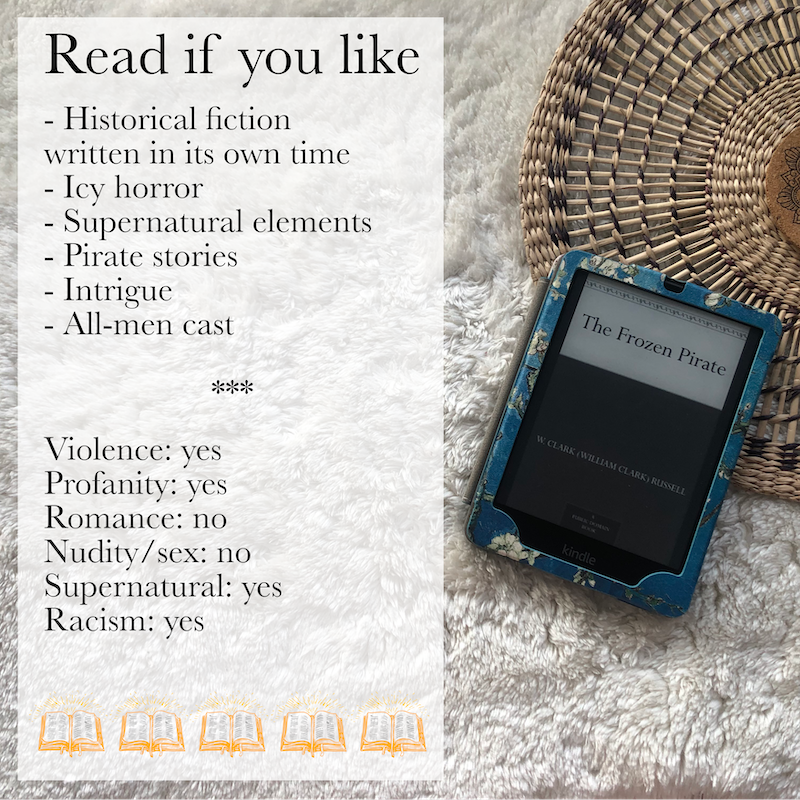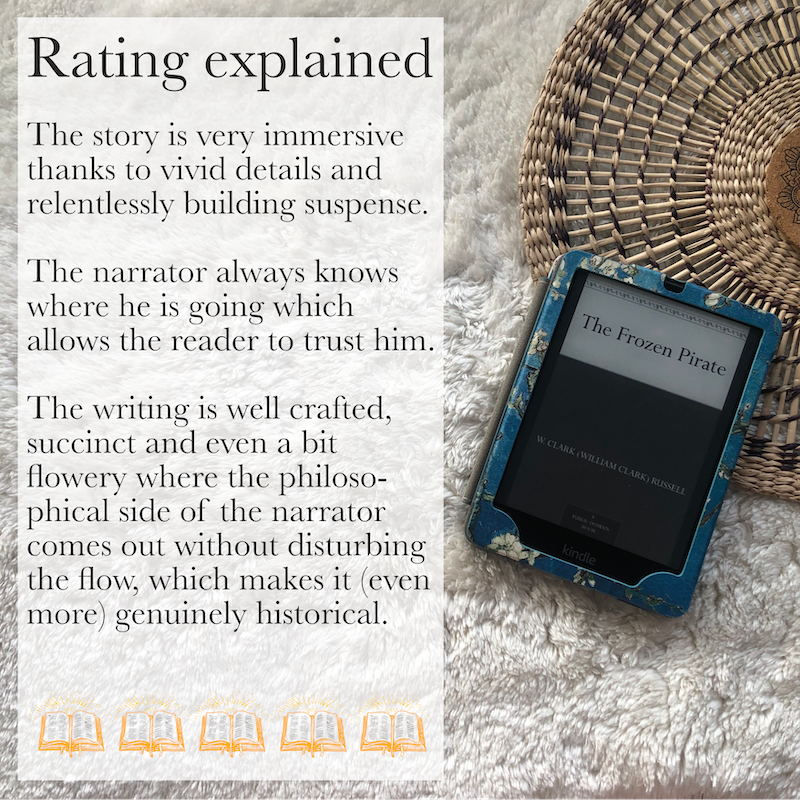The Frozen Pirate (1887) was written by William Clark Russel.
The Frozen Pirate (1887) is a masterpiece standalone for lovers of pirate horror stories. Its author, William Clark Russel, boasts eight years of nautical experience as a sailor himself, and he wisely employs his knowledge of vivid details. He authored numerous nautical horror stories which were vastly successful at his time, even Sir Arthur Conan Doyle mentions these “fine sea stories” in The Five Orange Pips. If you are looking for historical fiction about pirates, magical realism with a mighty pinch of horror to curl your nails, a palpable pirate rogue, and a protagonist who is brutally honest about his failings as a human being, and you enjoy historical fiction about pirates, you need to read this book.

Synopsis of The Frozen Pirate (1887)

The protagonist Paul Rodney, an experienced sailor, escapes shipwreck by a hair’s width as the only survivor in the Antarctic region. He faces the real danger of freezing on his pinnacle, discovers a huge mass of ice and lands there to see if he can find anything useful. He discovers several frozen pirates, dressed in apparel of another time, and an ice-enclosed vessel filled with fine frozen food and drink to last many months. His pinnacle is unexpectedly gone, along with a huge chunk of ice onto which he had tied it. He has no choice but to seek refuge in the pirate vessel. He manages to make fire and enjoys some of the food, but soon the frozen bodies give him the creeps and he moves them out. Only one froze in such a position as to make it impossible to heave him out of the trapdoor, so he unfreezes him. Life returns to the pirate Tassard, who turns out to be a real rogue, but who can not deny he needs Paul to free the vessel from the ice. For now, Paul is safe, but he knows the pirate will not share his treasure.
Show spoiler
Evaluation of The Frozen Pirate (1887)
Historical fiction with undercurrents of other genres
The story is set in about the time of publication and therefore now fits in the category of pirate stories for adults in the historical fiction spectrum. Typical of writing of the time, the attitude towards cruelty is brutally honest. Peculiar to this story is its element of the supernatural, which reminds of Edgar Allen Poe with its oppressive feel, and surprised me because I had not considered the title in depth before reading.
Vivid characters in The Frozen Pirate
The two main characters, Paul Rodney and the frozen pirate, Tassard, vividly come to life, and I do not doubt the author had met pirates, or at least rogues, at sea, so believable were they. Particularly the pirate’s inability to believe he had been frozen for nearly five decades left a very realistic impression on me. Thus I fevered even for the rogue’s fate, though I may add that I love pirate adventures and this definitely influenced my opinion.
Paul Rodney’s character arc is, in my humble opinion, semi satisfying. His character is negatively influenced by the treasure, and in the voice of the time, the narrator stresses the honor Paul has in comparison to the pirate, though from today’s perspective with little success, as the idea of honor is quite different today. Thus, the narrator runs the risk that Paul’s standing up for himself is interpreted as rudeness, particularly in regard to the events that follow. Later, Paul is less severe, which turns the boat around just enough for forgiving readers.
It cannot be said that Tassard has a clear character arc, being erratic in nature. He doesn’t learn from the events that have befallen him, ignorant even of the possibility that he might have been frozen for some decades. Instead, he continues in his rogue ways in the belief he had just slept a day, despite his own suffering when he comes back to life. I was in awe of his depiction, which turned to pity as the story progressed.
A gripping plot and universal theme

The story is gripping throughout, and after the pirate moves for the first time, I was glued to the page, could not sleep without finishing. A possible theme could be the effect of riches on the human soul, as the pirate is greatly affected by it and even the protagonist shows us some of his darker sides when considering how he could flee with the share he considers his. The only question that might have been left unanswered, the matter of how it is possible a frozen corpse returns to life, is answered in the postscript.
A slow building pace
This is a slow building and very realistic horror story, despite, or perhaps enhanced by, its supernatural elements. The story never drags, the tension rises steadily and never stops until the very end, which renders the ending satisfying.
The Frozen Pirate‘s archaic, captivating prose
The writing is, understandably, historical and the voice compelling if one enjoys this writing style (I do), and one can stomach the historic world view, some archaic spellings, sailor jargon of a time long gone, and word choice that, at times, seems a bit off from today’s reading. The use of language in The Frozen Pirate tells us a lot about the times the author, and the narrator, lived in, which cements it right in the historical fiction genre.
The author, having vast experience in sailing himself, the descriptions of the sailor’s actions, way of thinking, and description of the weather he encounters, is insightful and vivid. Take, for example, this description of the storm:
“In a breath the brig was smothered with froth torn up in huge clouds, and hurled over and ahead of her in vast quivering bodies that filled the wind with a dismal twilight of their own, in which nothing was visible but their terrific speeding. Through these slinging, soft, and singing masses of spume drove the rain in horizontal steel-like lines, which gleamed in the lightning stroke as though indeed they were barbed weapons of bright metal, darted by armies of invisible spirits raving out their war cries as they chased us.”
William Clark Russel in The Frozen Pirate (1887)
The idea of a strongly foaming ocean like this, with “bodies” of it flying around, and the imagery of the rain being “war cries as they chased us,” is truly terrifying, and hints at the darkness and the corpses that follow, setting not only the mood but creating anticipation. One can almost hear the hissing wind in “these slinging, soft, and singing masses of spume,” which shows phonological talent in the author, and really immerses the reader by use of the senses.
Russel is undeniably a master storyteller whose few archaic spellings like ‘Buonaparte’ give an authentic feel to the historical setting; it gives the reader insight into the times, for the name had not yet made rounds enough, likely more by word of mouth than in written form, and a uniform spelling had not yet been established. But he also comes up with brilliant descriptions which have nothing to do with the historical context such as “[l]iquid gloom.”
Striking in most of Russels sea stories is the sailor jargon. Words like binnacle lamp, lazerette hatch, companion, staysail, spars, caboose, hawser, pinnace, fall on the regular, and have landlubbers grab the dictionary. Beside the jargon Russel shows his expertise in the way Paul Rodney comes to conclusions:
“But now I noticed that the weight of the hamper being on the larboard side, balanced the list the vessel took from her shifted ballast, and that she floated on a level keel with her bows fair at the sea, whence I concluded that a sort of sea-anchor had been formed ahead of her by the wreckage, and that it held her in that posture, otherwise she must certainly have fallen into the trough.”
William Clark Russel in The Frozen Pirate (1887)
Likewise, the narrator is not at loss of words for describing the sea, as can be seen by the two following quotes:
“The sea was a deep blue, heaving very slowly, though you felt the weight of the mighty ocean in every fold.”
“In the blackness of the first night the sea boiled all about me.”
William Clark Russel in The Frozen Pirate (1887)

The historic world view cements the narration in historical fiction with narrator’s input like:
”It is among the wonders of human nature that antagonisms should be found to flourish under such conditions of hopelessness, misery, and anguish as to make those who languish under them the most pitiful wretches under God’s eye.”
William Clark Russel in The Frozen Pirate (1887)
What is prominent in most historical fiction stories and which also plays out in The Frozen Pirate is the idea that character can be seen in physical appearance, such as in the sentence: “His hair showed him hoary in vice.”
Similarly, the lexial choices make vivid a time far removed from ours with expressions like “white-livered creature,” (said of Tassard), or exclamations like “thunder and fury!” and “for a wizard’s inkhorn,” and even the protagonists thoughts such as when he thinks “I should speedily bestir myself.”
While these stylistic devices were probably not used with the idea of the modern reader in mind, they very effectively, in their interplay and in summary, immerse the reader in the historical setting.
Strong impact
The story left a strong impression of awe on me, and I will definitely read it again at some point, and definitely some of the author’s other celebrated books. The characters were so vivid and the story, despite its supernatural element, so realistically told, that when I put the book down, I felt as though I had just time traveled.
Recommendable read
I highly recommend The Frozen Pirate (1887) to readers who enjoy historical fiction about pirates written in its own time, some horror, and immersive reading. It’s one of the best pirate stories I ever read, and I almost swallowed it whole.
If you do decide to read this book, I’ll be very happy to read your thoughts about it below in the comment section of this book reviews blog!
Golden Books Rating of The Frozen Pirate (1887)

Five of five Golden Books for The Frozen Pirate (1887) by William Clark Russel.

Violence
Yes
Profanity
Yes
Romance
No
Nudity/sex
No
Supernatural
Yes
Racism
Yes
I could not find any drawback in this story.
Sources
- Russel, William Clark: The Frozen Pirate (1887).
FAQ
What is The Frozen Pirate about?
The Frozen Pirate is a thrilling adventure and horror novel originally written in 1887 by W. Clark Russell. It follows the story of a sailor who discovers a frozen pirate ship in the Antarctic. Inside, he encounters a pirate miraculously preserved in ice, leading to unexpected events filled with danger, mystery, and intrigue. This edition, reviewed and featured on Mira Kanehl’s site, delves into the novel’s captivating themes and timeless appeal.
Is The Frozen Pirate suitable for modern readers?
Yes! Despite being written in the 19th century, The Frozen Pirate appeals to modern readers with its engaging plot, vivid descriptions, and timeless themes of adventure, greed and survival. Mira Kanehl’s review highlights how the story remains relevant and exciting for today’s audience, making it a perfect choice for lovers of classic literature and maritime tales.
Where can I buy The Frozen Pirate featured on this page?
You can purchase The Frozen Pirate directly through the purchase link provided on Mira Kanehl’s book review page.
What makes this edition of The Frozen Pirate unique?
This edition of The Frozen Pirate is more than just a reprint. Mira Kanehl offers an insightful review that contextualizes the novel, enhancing your reading experience with thoughtful commentary on the book’s literary significance, plot dynamics, and historical background. She also took the time to research outdated words and annotated them, and formatted the book professionally for enhanced reading pleasure.
Can I read a sample of The Frozen Pirate before purchasing?
Yes, Mira Kanehl offer the option to preview a sample of The Frozen Pirate before purchase. This allows readers to get a taste of the writing style, professional formatting and the intriguing opening of the story.
Is there a version of The Frozen Pirate for dyslexic people?
Yes, Mirà Kanehl offers a version that is easy to read for dyslexics, specifically for those who don’t have the dyslexic option on their reading device.
Like what you’re reading? Share it!
This is going to be incredibly useful for my work.
Thank you Blogi Nauki, I appreciate it! 🙂
Reading this piece felt like walking through a beautiful garden of ideas — each thought more inviting than the last.
Thanks TyT! I appreciate it! 🙂
Very insightful read—definitely bookmarking this site for future reference.


Leave a Reply